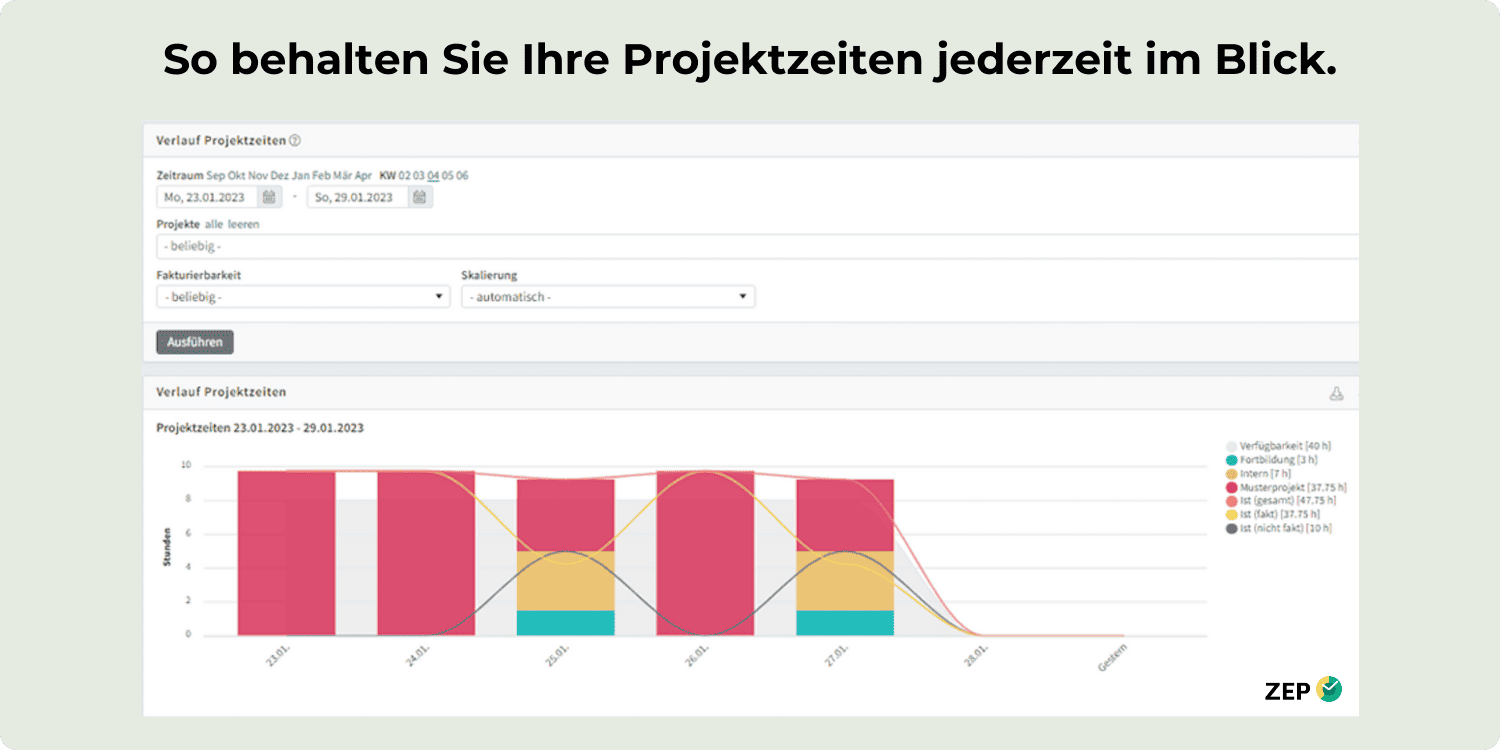
A new project is on the horizon - be it a new customer order or the completion of an extensive internal task. A project manager is appointed to allocate tasks and issue instructions to the team. While the team members concentrate on their individual tasks, the project manager is responsible for maintaining a comprehensive overview and providing information on the current project status at all times.
The project report is an effective tool for capturing all relevant information in a hectic environment. In this blog article, you can find out more about the functions a project report fulfils, how it should be structured and which tool you can use to further optimise your reports.
Reporting during the course of the project serves as a written summary of the current project status and is prepared in accordance with the project plan. In the Gabler Business Dictionary the term "reporting" is defined as follows:
"Term for all systematically prepared reports in written or electronic form that contain information relevant to decision-making and management. The aim of reporting is generally to meet the information needs of the report recipients; in particular, the creation of transparency and the preparation and control of decisions are emphasised."
A project report therefore provides neutral information about the progress of your project, shows results to date, highlights potential changes or problems and, in particular, indicates the degree to which the objectives have been achieved.
The project report is therefore often referred to as a status report. The frequency of reporting can vary depending on the duration, scope and complexity of the project - however, a regular cycle is defined as part of the project.
The project report is essential for the management in order to Profitability of your projects in view. As the project manager, you focus in particular on whether and when the individual project goals are achieved. Your team also receives neutral information about any problems, changes or possible solutions for future work steps. Your stakeholders can also use the project report to track progress over time and determine which objectives have already been realised or are still outstanding. The provision of this neutral information contributes to greater transparency, added value and trust at all levels.
The central objective of a project report is therefore to inform all relevant stakeholders - starting with the members of your project team and extending to management and your clients. Reporting is an integral part of project controlling. You should make sure that the following questions can be answered in detail, in a way that everyone can understand and is immediately recognisable:
1. what are the results of the project so far?
2. which decisions still need to be made and by whom?
3. which tasks are still outstanding?
4. what phase is the project currently in?
Your project report should serve as an initial briefing and introduction to the project, both for active project participants and for people who are not actively involved in the project but simply need to be informed about progress.
In its entirety, a project report has the task of conveying all relevant information relating to the project and its progress. No questions should be left unanswered when reading the report. Your management is primarily interested in which employees - i.e. human resources - are involved in the project and how much budget has already been spent. Your customers and other stakeholders, on the other hand, would rather know how much they will have to pay for the project in the end. As the project manager, you need a comprehensive overview of all the details of the project and should ensure that the following criteria are included in your project report:
The project name: Especially if your company manages many projects, clear naming of each project is crucial. This may seem obvious, but precise naming of files and headings helps to save time.
The people involved: The number of project employees provides information about the scope. If the project takes longer, it may be necessary to increase the team or reallocate tasks. At this point, you should adjust the project plan if necessary.
The status: Have you already completed the project or is it still in progress? Here you can note whether parts of the project have already been invoiced to the customer. The status is particularly important in your project report if the reader is reading the report alone or has to keep track of several projects.
The running time: The duration of a project should always be visible in your project report. Not only so that your superiors and customers can get an overview of the time frame, but also to ensure that costs are kept within budget. If the duration is too long for a small project, you may need to adjust the project management or project planning and speed up the processes.
The resources: The budget of your project - in terms of money and personnel - is of crucial importance. A visualisation of how much has already been spent supports further planning. If the budget is not sufficient to achieve the project goals, you should make adjustments and communicate these to all project participants and stakeholders.
The subtasks: Subdivide Split main tasks into several subtasks or task packages. This allows you to keep track of tasks that have already been completed. If certain steps take longer than planned, you should take appropriate measures and note this in your project report.
The turnover: The information about how much turnover your project has already generated is of particular interest to your management. The turnover can be compared with the budget in order to determine the expenditure that your customer is still prepared to pay.
The traffic light system: Coloured markings in the project report provide immediate insight into the current project status. A traffic light system with the familiar colours is particularly suitable for this. Please note: Define the colours as clearly as possible in advance so that no questions remain unanswered when reviewing the project report.
Now you know what content should be included in your project report. But: In addition to the content components, the structure and organisation of a project report also follow a classic pattern:

In the introductory section, you outline the context and general conditions of your project. Here you present the key information, such as the project name or project number. This ensures that the readers of your report can clearly identify which project it is - which is particularly useful in this case, if you have several projects (possibly even for one and the same customer) in parallel.
The introduction also includes a list of all persons involved, including sponsors, stakeholders and team members. You define the project duration by specifying the start and end dates as well as the duration of work carried out to date. In the introduction to your project report, you can also explain whether you use a traffic light system for status reports and how this is to be interpreted by the reader. Also remember to include the creation date of your project report. This will emphasise how up-to-date the document is.
In the main part of the report, you describe the project development and compare the current status with the Target values of your project plan. Address important aspects:
- What tasks have been completed so far?
- What are you currently working on?
- Are there any changes to the original project plan?
And analyse your goals:
- What goals have been achieved so far?
- What goals still need to be achieved?
- Are there goals that can no longer be realised?
In the main part of your project report, also include the results you have achieved so far with your team and highlight the most important progress. Also consider the resources and explain what resources you have actually needed in comparison to your defined project plan - in terms of personnel, time and money.
In the main section, discuss whether you have identified any potential problems or risks for the further course of the project, how you could solve them and how much time you may need to do so. If necessary, create a detailed solution concept so that no questions remain unanswered for the reader of the report.
Use concrete figures, avoid empty phrases and digressions. Your project report should be short, clearly structured and focussed on the essentials. It does not replace cost analyses or quality controls, but merely shows an overall status on the basis of which you can make further decisions.

In the conclusion of your project report, you should briefly summarise the progress made so far. If unexpected problems or changes arise during the project and these have an impact on the next steps, please pay particular attention to them and mention them separately. This enables a precise assessment of the current project status and targeted planning for the next phases of your project.
Write your project report either in the present or past tense - the latter is the most common formulation. Use clear and concise wording without filler words. Use active sentence constructions - for example: "We have decided that ..." instead of "It was decided that ...".
Always adapt the terminology in the project report specifically to your customers. Avoid complex sentence structures and unnecessary nouns.
Use older project reports in your company as a guide to understand the writing style and adopt it if necessary. In many cases, it is sufficient to use an existing project report as a sample and use it as a basis for further reports. But be careful:
Customisation of the report is particularly important for special projects with a unique structure or special conditions!
As a project manager, you can quickly lose sight of the project report in your hectic day-to-day work. New information is constantly flowing in and integrating it takes up valuable time. In the midst of your numerous tasks, project-related time recording can easily be forgotten.
However, by using software such as ZEP, you not only effortlessly record your working hours, but also the hours for customers, projects and services rendered. With ZEP, you and your team clock in and out on a project-specific basis, creating a solid foundation for your project report. You always have an overview of who is working how much on which project and can easily export the corresponding analyses from the programme. This makes incomplete information and slow billing processes a thing of the past.

Project time tracking software such as ZEP makes it easier for you to recognise when budgets are reaching their limits and to initiate appropriate countermeasures. Once you have successfully completed a project, you can use the Invoicing module invoice your customer for all project hours spent directly from the software.
Thanks to the ZEP's diverse functions design your project report step by step yourself. Test our software free of charge and without obligation for 30 days.


Read article ↗

How can you strengthen your employer brand and attract the best talent? Discover 11 effective employer branding measures that will help you stand out from the competition and optimise your recruitment strategy.
Read article ↗
We answer your questions quickly & competently. Contact us by phone or email.
+49 7156 43623-0 or contact form